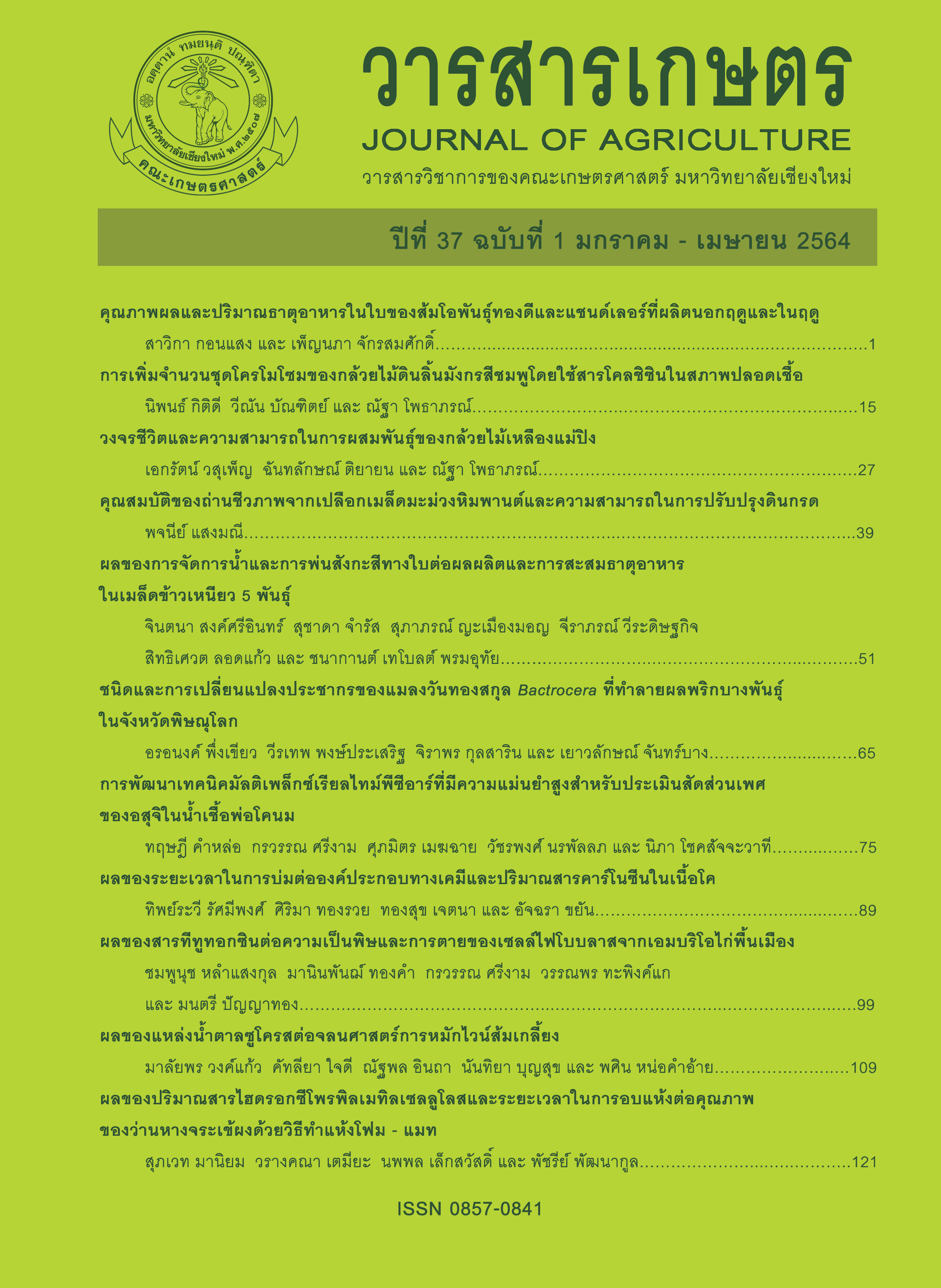ผลของปริมาณสารไฮดรอกซีโพรพิลเมทิลเซลลูโลสและระยะเวลาในการอบแห้งต่อคุณภาพของว่านหางจระเข้ผงด้วยวิธีทำแห้งโฟม - แมท
Main Article Content
บทคัดย่อ
จุดประสงค์ของการศึกษาในครั้งนี้เพื่อหาปริมาณที่เหมาะสมของสารไฮดรอกซิลโพรพิลเมทิลเซลลูโลส(HPMC: 1, 2, 3 และ 4 %) และระยะเวลาในการอบแห้ง (12, 16, 20 และ 24 ชั่วโมง) ในการทำแห้งว่านหางจระเข้ผงด้วยวิธีโฟม - แมท พบว่า การเติมสาร HPMC ความเข้มข้น 1 % ส่งผลมีค่าการเกิดโฟมสูงที่สุดเท่ากับ 493.83 % โดยความร้อนสามารถกระจายตัวผ่านโฟมว่านหางจระเข้ที่อยู่ในถาดอบได้ง่าย จึงส่งผลให้ได้ค่าความชื้นของผลิตภัณฑ์ต่ำที่สุดเท่ากับ 4.91 % และค่ากิจกรรมการต้านอนุมูลอิสระสูงที่สุดเท่ากับ 0.74 มิลลิกรัมต่อกรัมตัวอย่าง (trolox equivalent) สำหรับการศึกษาระยะเวลาในการอบแห้ง พบว่า การอบแห้งในช่วง 12 ถึง 24 ชั่วโมง ไม่ส่งผลต่อการเปลี่ยนแปลงปริมาณผลผลิตที่ได้อย่างมีนัยสำคัญ ซึ่งค่าที่ได้อยู่ในช่วง 16.36 - 16.90 % อย่างไรก็ตามการทำแห้ง 16 ชั่วโมงจัดเป็นเวลาอบแห้งที่เหมาะสมที่สุด เนื่องจากทำให้ได้ค่าความชื้นเท่ากับ 6.69 % ซึ่งภายใต้เกณฑ์มาตรฐานผลิตภัณฑ์ชุมชนของสมุนไพรรวมอบแห้ง นอกจากนี้การทำแห้งที่ 12 และ 16 ชั่วโมงไม่ส่งผลต่อการเปลี่ยนแปลงค่าความสามารถในการละลายน้ำอย่างมีนัยสำคัญ ซึ่งมีค่าเท่ากับ 84.47 และ 80.46 % ตามลำดับ
Article Details
เอกสารอ้างอิง
Amin, K., S. Ozgen and Z. Selamoglu. 2018. Aloe vera: a miracle plant with its wide-ranging applications. Pharmacy and Pharmacology International Journal 6(1): 00144, doi: 10.15406/ppij.2018.06.00144.
Angsuphanit, K. 1993. Food Processing. Kasetsart University Press, Bangkok. 138 p. (in Thai)
AOAC. 2000. Official Methods of Analysis. 17th ed. Association of Official Analytical Chemists, Gaithersburg, MD.
Bikerman, J.J. 1973. Foams. Springer-Verlag, New York. 337 p.
Carneiro, H.C.F., R.V. Tonon, C.R.F. Grosso and M.D. Hubinger. 2013. Encapsulation efficiency and oxidative stability of flaxseed oil microencapsulated by spray drying using different combinations of wall materials. Journal of Food Engineering. 115(4): 443-451.
Ekpong, A., W. Phomkong and E. Onsaard. 2016. The effects of maltodextrin as a drying aid and drying temperature on production of tamarind powder and consumer acceptance of the powder. International Food Research Journal 23(1): 300-308.
Hendrawati, T.Y. 2015. Aloe vera powder properties produced from Aloe chinensis Baker, Pontianak, Indonesia. Journal of Engineering Science and Technology Special Issue 1: 47-59.
Inkaew, C., T. Keokamnerd, C. Rardniyom and K. Arkanit. 2015. Effects of date-to-water ratio and foaming agents on foam quality prior of foam mat drying. pp. 231-240. In: Proceedings of Academic Conference. Maejo University, Chiang Mai. (in Thai)
Iqbal, J.M., A. Abbas, H. Rafique, F.M. Nawaz and A. Rasool. 2018. A review paper on foam-mat drying of fruits and vegetables to develop powders. MOJ Food Processing and Technology 6(6): 465-467.
Jay, J.M. 1996. Modern Food Microbiology. 5th ed. Chapman & Hall, New York. 661 p.
Pnongthai, S., S. D’Amico, R. Schoenlechner, W. Homthawornchoo and S. Rawdkuen. 2018. Fractionation and antioxidant properties of rice bran protein hydrolysates stimulated by in vitro gastrointestinal digestion. Food chemistry 240: 156-164.
Puechkaset. 2014. Properties of aloe vera and implantation (Online). Available: http://puechkaset.com/aleo vera (March 2, 2020).
Ramadhia, M., S. Kumalaningsih and I. Santoso. 2012. The making of aloe vera powder (Aloe vera L.) with foam-mat drying method. Jurnal Teknologi Pertanian 13(2): 125-137.
Raymundo, A., J. Empis and I. Sousa. 1998. Method to evaluate foaming performance. Journal of Food Engineering 36(4): 445-452.
Sriroth, K., and K. Piyachomkwan. 2003. Technology of Starch. 3rded. Kasetsart University Press,Bangkok. 303 p. (in Thai)
TISI. 2005. Dried mixed herbs. Thai Community Product Standard, TCPS 996/2005. Thai Industrial Standard Institute, Bangkok. 5 p.
Upanan, S. 2019. Department of Agricultural Extension, District/Provincial Agricultural Extension Office, Growers. Information on February 28th, 2019. 65-66. (in Thai)
Vamshikrishna and H. Rahman. 2012. Evaluating aloe vera powder as bioavailability enhancer. Journal of Bioequivalence and Bioavailability 4(3): 191.
Wikipedia. 2020. Water. (Online). Available: http://th.m.wikipeda.org/wiki/water (February 15, 2020).


